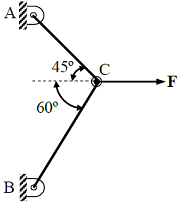GATE 2017-2018 :: GATE Mechanical
-
A force of 400 N is applied to the brake drum of 0.5 m diameter in a band-brake system as shown in the figure, where the wrapping angle is 180°. If the coefficient of friction between the drum and the band is 0.25, the braking torque applied, in N.m is

- A box contains 4 red balls and 6 black balls. Three balls are selected randomly from the box one after another, without replacement. The probability that the selected set contains one red ball and two black balls is
- Consider the differential equation x2 d2y/dx2 + x dy/dx - 4y = 0 with the boundary conditions of y(0) = 0 and y(1) = 1. The complete solution of the differential equation is
-
x + 2y + z = 42x + y + 2z = 5x - y + z = 1The system of algebraic equations given above has
-
Two steel truss members, AC and BC, each having cross sectional area of 100 mm2, are subjected to a horizontal force F as shown in figure. All the joints are hinged.
 If F = 1 kN, the magnitude of the vertical reaction force developed at the point B in kN is
If F = 1 kN, the magnitude of the vertical reaction force developed at the point B in kN is -
Two steel truss members, AC and BC, each having cross sectional area of 100 mm2, are subjected to a horizontal force F as shown in figure. All the joints are hinged.
 The maximum force F in kN that can be applied at C such that the axial stress in any of the truss members DOES NOT exceed 100 MPa is
The maximum force F in kN that can be applied at C such that the axial stress in any of the truss members DOES NOT exceed 100 MPa is -
A refrigerator operates between 120 kPa and 800 kPa in an ideal vapor compression cycle with R-134a as the refrigerant. The refrigerant enters the compressor as saturated vapor and leaves the condenser as saturated liquid. The mass flow rate of the refrigerant is 0.2 kg/s. Properties for R-134a are as follows:
 The rate at which heat is extracted, in kJ/s from the refrigerated space is
The rate at which heat is extracted, in kJ/s from the refrigerated space is -
A refrigerator operates between 120 kPa and 800 kPa in an ideal vapor compression cycle with R-134a as the refrigerant. The refrigerant enters the compressor as saturated vapor and leaves the condenser as saturated liquid. The mass flow rate of the refrigerant is 0.2 kg/s. Properties for R-134a are as follows:
 The power required for the compressor in kW is
The power required for the compressor in kW is -
Air enters an adiabatic nozzle at 300 kPa, 500 K with a velocity of 10 m/s. It leaves the nozzle at 100 kPa with a velocity of 180 m/s. The inlet area is 80 cm2. The specific heat of air Cp is 1008 J/kg.K.The exit temperature of the air is
-
Air enters an adiabatic nozzle at 300 kPa, 500 K with a velocity of 10 m/s. It leaves the nozzle at 100 kPa with a velocity of 180 m/s. The inlet area is 80 cm2. The specific heat of air Cp is 1008 J/kg.K.The exit area of the nozzle in cm2 is


 Whatsapp
Whatsapp
 Facebook
Facebook

